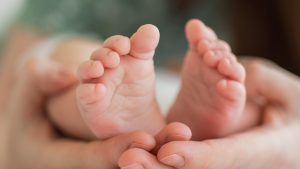Approfondimenti scientifici
Dynamic development of the infant foot: biomechanics, neuro-sensoriality and functional implications in the first steps
Foot development represents a crucial aspect of the neuromotor maturation of the newborn and infant, as it constitutes the fundamental biomechanical basis for the acquisition of the upright position and autonomous walking.
One of the typical characteristics of the infant foot is the presence of a prominent subcutaneous fat pad, which gives it an apparently absent plantar arch. This conformation, commonly known as “chubby foot,” is physiological and provides protection to the bone and tendon structures still in formation. The fat deposit also serves as cushioning, allowing the child to gradually support body weight without prematurely overloading delicate structural components.
The newborn’s foot is, in fact, largely composed of cartilaginous tissue, with bones still in the ossification phase and a medial arch not yet defined. This configuration is normal until 3–5 years of age, when the development of ligaments, intrinsic muscles, and tendons leads to the progressive reduction of the adipose tissue and the definitive formation of the plantar arch, fundamental for a balanced load distribution and adequate biomechanical functioning during walking.
Natural plantar stimulation at this stage represents an essential stimulus for the maturation of proprioceptive and sensory pathways, which support balance and motor coordination. The cutaneous and deep receptors of the foot, such as Meissner, Pacini, and Ruffini corpuscles, send signals to the central nervous system facilitating postural adaptation and movement control. Early exposure to variable and non-invasive stimuli on the sole of the foot also contributes to improving somatosensory sensitivity and developing intrinsic muscle strength necessary to support verticalization and weight-bearing.

Sensory stimulation and postural integration
Tactile and proprioceptive stimulation plays a crucial role in promoting the functional maturation of the foot. Exposure to variable sensory stimuli, such as contact with different surfaces and active or passive movement of the lower limbs, facilitates the activation of cutaneous and musculo-tendinous receptors. These sensory inputs help improve body awareness and calibrate motor responses, favoring the emergence and consolidation of the plantar arch.
An adequate motor context, including freedom of movement and opportunities for progressive load, is therefore essential to support the natural biomechanical development of the foot and to prevent postural or functional alterations that could compromise the entire kinetic chain of the child. In this sense, natural plantar stimulation does not act only as a means of protection from mechanical overload, but also plays an important role in fostering neuroplasticity and sensori-motor integration, fundamental for harmonious and functional motor growth.
It is important to underline that postural and motor development is the result of an integrated and complex system involving not only the lower limbs, but also the oral cavity and pelvis, forming an integrated functional and neuromotor axis. The relationship between oral cavity, pelvis, and foot is expressed through muscular chains and postural reflexes that allow coordination of fine and gross movements necessary for locomotion. For example, sucking, chewing, and swallowing abilities in the newborn (primary functions of the oral cavity) are closely related to muscle tone and pelvic stability, which in turn influence plantar support and load capacity. Dysfunctions or alterations in one of these districts may reflect along the axis and compromise overall functionality.
Therefore, sensory stimulation of the foot does not act in isolation, but contributes to modulating global postural tone and improving dynamic balance, facilitating better neuromotor integration along the entire oral–pelvis–foot axis.
Motor development and the prevention of postural dysfunctions
Foot development in the newborn, characterized by the physiological presence of the “chubby foot,” thus represents a fundamental and indispensable stage in the progressive achievement of autonomous locomotion. Natural stimulation of the sole of the foot, especially when supported by innovative tools and careful multidisciplinary management, facilitates the sensory and muscular activation necessary for correct biomechanical and neuromotor development.
For this reason, it is crucial that such stimulation strategies be included in a context of global and multidisciplinary care that takes into account the child’s individual characteristics and promotes an early, personalized, and integrated approach. The interaction between pediatricians, rehabilitation therapists, speech therapists, and movement specialists is essential to maximize developmental potential and prevent possible delays or postural dysfunctions.
Finally, although current clinical evidence is promising, further rigorous and longitudinal research is needed to confirm and optimize the use of innovative techniques and technologies in plantar stimulation, in order to effectively support infant motor development and children’s quality of life.
Clinical indications: Welcome Pod: innovation in natural plantar stimulation
Welcome Pod is an ergonomic device designed to offer natural and gradual plantar stimulation to newborns and infants. Designed to be used both passively and actively, the system makes it possible to reproduce oscillatory movements, targeted vibrations, and variations in pressure on the sole of the foot, stimulating sensory receptors and promoting muscle activation.
Preliminary studies suggest that regular use of Welcome Pod may accelerate proprioceptive maturation and improve postural control ability in the first months of life, thus facilitating the acquisition of essential motor prerequisites for walking.
Orfeo, L., & Vicario, M. (2021). Neuroplasticity and early motor development: the role of sensory stimulation in infancy. Journal of Pediatric Neurorehabilitation
Smith, A. B., & Jones, C. D. (2019). Proprioceptive stimulation and postural control in infants: implications for motor development. Developmental Medicine & Child Neurology,
Gibson, E. J. (2020). The influence of plantar sensory input on postural stability and gait in early childhood. Neuroscience Letters
Brown, R. M., & Wilson, K. J. (2018). The interconnectedness of oral-motor function and postural alignment in infants: a review. Pediatric Physical Therapy
Kirk, R., & Doidge, N. (2022). Integrative neuromotor approaches to early childhood locomotion. Journal of Motor Behavior
Garcia, M. A., & Thompson, P. L. (2021). Foot development and the effects of proprioceptive interventions in infants. Clinical Biomechanics
Wilson, T. G., & Miller, D. F. (2019). Postural chains and their role in motor coordination: focus on the oral cavity, pelvis, and lower limbs. Journal of Bodywork and Movement Therapies
Santoro, L., Orfeo, L., & Mancini, F. (2023). Early intervention and sensorimotor integration in pediatric populations: innovative tools and outcomes. Pediatric Rehabilitation
Lee, J. H., & Park, S. Y. (2020). Sensory stimulation devices and their efficacy in promoting infant motor milestones. Early Human Development
Morales, E., & Vazquez, R. (2018). The role of plantar tactile input in neurodevelopmental disorders: a systematic review. Developmental Neurorehabilitation
